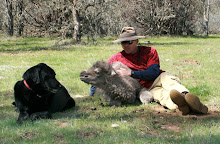
Most people tend to think that a camel's hump is a repository of water for the enhancement of their desert survival. This idea is but one of the many legends that surround the mysterious camel.
If you give thought as to how much a camel might drink in the hot desert you will quickly realize that a hump or two full of water wouldn't last long enough to help much in drought conditions.
A camel's hump is actually comprised of dense fat tissue, and sinew. The humps serve several known purposes.
One is to support the camel through long periods without nourishment. Camels adapted to harsh conditions have been known to survive more than 40+ days without food or water. The fat in the humps is consumed during long periods without food. Surviving without water is made possible because the camel's physiology becomes highly adept at moisture conservation, giving them the ability to do without additional water intake for very long periods.
Other purposes of the humps are to help regulate temperature. The humps provide increased surface area, which in hot weather can allow for greater regulation of body temperature through the skin and extra fat. In cold weather the humps of fat along the back provide additional reserves of body warmth.
Also, in the realm of legend, is another story about camel humps; a story that came to me the other day while observing some camel antics. This story is mythic. It is also symbolic of the world's need for man's re-awakening, and of the non-humans' patience with us, while we still sleep.
Camels can be looked at from physical and scientific points of view. They can also be seen from many other points of view.
There is their own point of view. There is the point of view that their predators have of them. They can be seen from the viewpoint of the birds overhead, or the birds who break open the camels' dung to find seeds. Or the view of them by the soil beneath their feet.
A camel, like anything else, is never just one thing... unless we make it so.
Looking at camels, or looking at anything, from as many, and varied, points of view as possible changes our view of reality and deepens our understanding of any one thing, and of everything. "We are more than what we look like."
Picture a camel (one humped or two) standing in an open grassy field. Picture it gallivanting about, jumping, bucking, twisting, rearing up on its hind legs, leaping exuberantly as if trying to fly. Can you picture a camel flying? What would it look like? Do you think camels have the impulse to want to fly? I know I do...

Did you know that camels actually once did fly? And that they might do so again? Folded tightly and neatly within those humps are their now dormant wings, with which they used to use to soar through the skies.
When humans once allowed themselves and the world to be free and wild, the ancestors of today's camels used to be the creatures we now, in our imaginations, call dragons. We rode them in the skies. We were partners. Now, neither of us fly. We both share the memory and the desire to fly again, but we humans are now afraid, and our fear keeps the world around us from being free.
So the camels wait. They wait until we are ready. And in the meantime, if you ever get the chance to know a camel up close, and with due respect, you may notice that they will try to help you beyond your fear, because they know that in such direction lies our, and their, renewed flight, and freedom.
Throughout recorded history camels have been beasts of burden, carting us and our goods across continents, into war, over deserts. The wild herds live in remote places, as far from human fear as possible. Both wild and domestic camels are waiting, as are all creatures, for humans to let go of our fear so that all can be free again, and again to live as equals, at heart.

Look into a camel's eyes and you may come to feel that this is true.
One day, now, when we have surpassed our fear, the great wings within the camels' humps will unfold once more, and they will begin to fly again, and we will know we are free!
 The gates at the head of Peaceful Camel Valley currently consist
The gates at the head of Peaceful Camel Valley currently consist ur Sacred Camel Valley sign features an image of Allen Deutsch's great, "Tom Dooley", probably the best white Bactrian bull in the country.
ur Sacred Camel Valley sign features an image of Allen Deutsch's great, "Tom Dooley", probably the best white Bactrian bull in the country.




















